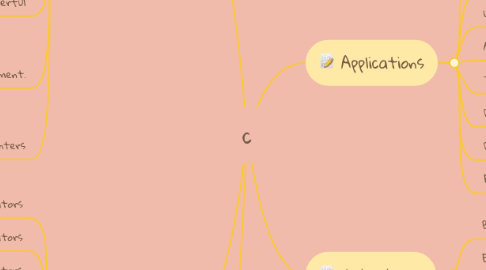
1. features
1.1. modularity
1.1.1. Modularity is the ability to breakdown a large module into sub-modules that are easy to manage
1.2. Portability
1.2.1. C Language programs are portable that allows it to run on different operating systems. Because of the portability feature, programs written in C works on different computer systems with little or no modifications.
1.3. Extendability
1.3.1. Another feature of C is extendability. It is an ability to extend the existing software by adding some new features.
1.4. Speed
1.4.1. C programs run faster. ‘C’ is also called a middle-level language. Actually, it has advantages of both high level and middle-level languages. Programs written in ‘C’ language run at the speeds equals to that of the same programs written in assembly language. Therefore, C Language mostly used for system software development.
1.5. Powerful
1.5.1. C language provides a variety of data types, functions, and loops that makes it a powerful programming language.
1.6. Memory Management.
1.6.1. C Language supports the feature of dynamic memory allocation. You can free the allocated memory at any time by calling the free() function in C.
1.7. Pointers
1.7.1. C provides efficient use of pointers. Using pointers, you can directly interact with the memory.
2. operators
2.1. Arithmetic Operators
2.2. Relational Operators
2.3. Logical Operators
2.4. Assignment Operators
2.5. Increment and Decrement Operators
2.6. Conditional Operator
2.7. Bitwise Operators
2.8. Special Operators
3. basic syntax
3.1. C is a case sensitive language so all C instructions must be written in lower case letter.
3.2. ,,,,,,,All C statement must end with a semicolon.
3.3. Whitespace is used in C to describe blanks and tabs.
3.4. Whitespace is required between keywords and identifiers. We will learn about keywords and identifiers in the next tutorial.
4. Applications
4.1. Operating Systems
4.2. Language Compilers
4.3. Language Interpreters
4.4. Assemblers
4.5. Text Editors
4.6. Drivers
4.7. Database Programs
4.8. Embedded systems
5. data types
5.1. Basic data types
5.1.1. int, char, float, double
5.2. Enumeration data type
5.2.1. enum
5.3. Derived data type
5.3.1. pointer, array, structure, union
5.4. Void data type
5.4.1. void
